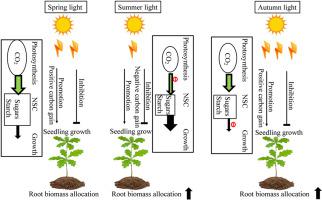当前位置:
X-MOL 学术
›
For. Ecosyst.
›
论文详情
Our official English website, www.x-mol.net, welcomes your feedback! (Note: you will need to create a separate account there.)
Understory seedlings of Quercus mongolica survive by phenological escape
Forest Ecosystems ( IF 4.1 ) Pub Date : 2024-03-21 , DOI: 10.1016/j.fecs.2024.100185 Shixiong Wu , Ying Liu , Lulu He , Wei Zeng , Qijing Liu
Forest Ecosystems ( IF 4.1 ) Pub Date : 2024-03-21 , DOI: 10.1016/j.fecs.2024.100185 Shixiong Wu , Ying Liu , Lulu He , Wei Zeng , Qijing Liu

|
Understanding understory seedling regeneration mechanisms is important for the sustainable development of temperate primary forests in the context of increasingly intense climate warming events. The poor regeneration of dominant tree species, however, is one of the biggest challenges it faces at the moment. Especially, the regeneration of the shade-intolerant seedling is difficult in primary forests, which contrasts with the extreme abundance of understory seedlings in secondary forests. The mechanism behind the interesting phenomenon is still unknown. This study used in-situ monitoring and nursery-controlled experiment to investigate the survival rate, growth performance, as well as nonstructural carbohydrate (NSC) concentrations and pools of various organ tissues of seedlings for two consecutive years, further analyze the understory light availability and simulate the foliage carbon (C) gain in the secondary and primary forest. Results suggested that seedlings in the secondary forest had greater biomass allocation aboveground, height and specific leaf area (SLA) in summer, which allowed the seedling to survive longer in the canopy closure period. High light availability and positive C gain in early spring and late autumn are key factors affecting the growth and survival of understory seedlings in the secondary forest, whereas seedlings in the primary forest had annual negative carbon gain. Through the growing season, the total NSC concentrations of seedlings gradually decreased, whereas those of seedlings in the secondary forest increased significantly in autumn, and were mainly stored in roots for winter consumption and the following year's summer shade period, which was verified by the nursery-controlled experiment that simulated autumn enhanced light availability improved seedling survival rate and NSC pools. In conclusion, our results revealed the survival trade-off strategies of seedlings and highlighted the necessity of high light availability during the spring and autumn phenological periods for shade-intolerant tree seedling recruitment.
中文翻译:

蒙古栎林下幼苗通过物候逃逸生存
在气候变暖事件日益激烈的背景下,了解林下幼苗再生机制对于温带原始林的可持续发展具有重要意义。然而,优势树种再生能力差是目前面临的最大挑战之一。特别是,原始林中不耐荫的幼苗再生困难,这与次生林林下幼苗的极其丰富形成鲜明对比。这一有趣现象背后的机制仍不清楚。本研究采用原位监测和苗控试验,连续两年调查幼苗的成活率、生长性能以及各器官组织的非结构性碳水化合物(NSC)浓度和库量,进一步分析林下光利用率和模拟次生林和原始林中的叶子碳 (C) 增益。结果表明,次生林中的幼苗在夏季具有更大的地上生物量分配、高度和比叶面积(SLA),这使得幼苗在冠层关闭期间能够存活更长的时间。早春和晚秋的高光利用率和正碳增益是影响次生林林下幼苗生长和存活的关键因素,而原始林幼苗的年碳增益为负。整个生长季节,幼苗的NSC总量逐渐下降,而次生林幼苗的NSC总量在秋季显着增加,主要储存在根部供冬季消耗和次年夏季遮荫期,经苗圃验证。 -模拟秋季增强光可用性的对照实验提高了幼苗成活率和 NSC 池。总之,我们的结果揭示了幼苗的生存权衡策略,并强调了春季和秋季物候期高光照对于不耐荫树苗招募的必要性。
更新日期:2024-03-21
中文翻译:

蒙古栎林下幼苗通过物候逃逸生存
在气候变暖事件日益激烈的背景下,了解林下幼苗再生机制对于温带原始林的可持续发展具有重要意义。然而,优势树种再生能力差是目前面临的最大挑战之一。特别是,原始林中不耐荫的幼苗再生困难,这与次生林林下幼苗的极其丰富形成鲜明对比。这一有趣现象背后的机制仍不清楚。本研究采用原位监测和苗控试验,连续两年调查幼苗的成活率、生长性能以及各器官组织的非结构性碳水化合物(NSC)浓度和库量,进一步分析林下光利用率和模拟次生林和原始林中的叶子碳 (C) 增益。结果表明,次生林中的幼苗在夏季具有更大的地上生物量分配、高度和比叶面积(SLA),这使得幼苗在冠层关闭期间能够存活更长的时间。早春和晚秋的高光利用率和正碳增益是影响次生林林下幼苗生长和存活的关键因素,而原始林幼苗的年碳增益为负。整个生长季节,幼苗的NSC总量逐渐下降,而次生林幼苗的NSC总量在秋季显着增加,主要储存在根部供冬季消耗和次年夏季遮荫期,经苗圃验证。 -模拟秋季增强光可用性的对照实验提高了幼苗成活率和 NSC 池。总之,我们的结果揭示了幼苗的生存权衡策略,并强调了春季和秋季物候期高光照对于不耐荫树苗招募的必要性。



























 京公网安备 11010802027423号
京公网安备 11010802027423号